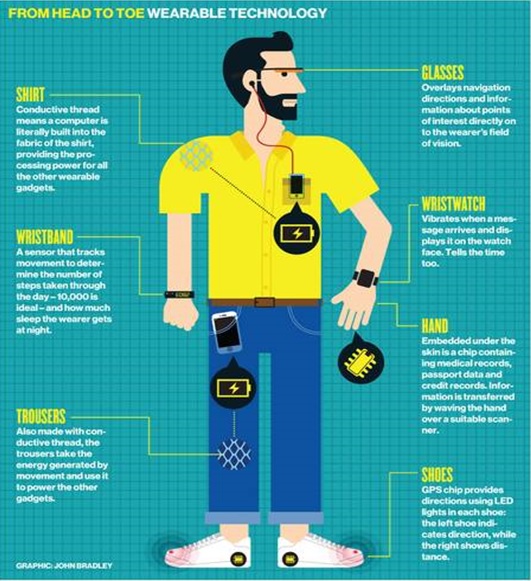What is it?
Wearable technology refers to small electronic devices that are worn by the user. Devices exist in many forms including glasses, watches and clothing. The emergence of this new range of devices has been driven by the growth and integration of sensors, systems and wireless technologies.
Why is it of interest?
The introduction of Google Glass and Pebble, as well a rumoured Apple iWatch have ignited interest. Wearable devices have the potential to offer more interactivity than laptops, smartphones, or tablets. They are designed to be seamlessly included into everyday life.
What are the applications?
Current applications are limited largely to smartwatches, sports and lifestyle tools (e.g. exercise, sleep and nutritional monitoring). The fashion industry is also participating, including a Bluetooth dress that lights up for incoming phone calls. While still an experimental field, several new developments are expected in the coming years. Business applications are yet to take off but there is belief this will change. The enhanced interactivity can be a source of benefit where two tasks cannot currently be done at the same time. For example it may offer a solution to a worker driving or operating machinery who can’t simultaneously use a handheld computer.
Are they standalone devices?
The developing nature of the industry means wearable technology is not yet perfected or necessarily standalone. Devices such as Google Glass still require a connection to a mobile device in order to perform certain functions. The future may see a single device that can combine the technology of its ancestors into a single watch or pair of glasses.
What are the adoption hurdles?
Regardless of the form wearable devices take, there will be obstacles to overcome. Currently one of the biggest is battery life. Solar power and kinetic charging are two of the possible solutions. Another critical issue is durability and robustness.
There will also be issues around privacy and security. Devices logging information about individuals such as location and experiences which may even include their field of vision could be an attractive target to hackers.
A fad or the future?
Despite the above issues, wearable technology looks set to become part of our lives. The market is estimated to be worth $800m this year, and is expected to grow to $6bn (70m devices) in 2018. The industry is hoping we become as comfortable with wearing technology as we currently are with glasses, clothing and watches.

Article by Alexander Jefcoate and Frederick Callaghan
Sources:
Juniper Research - Mobile Wearable Devices & Smart Glasses to reach Sales of almost 70 million by 2017, finds Juniper Research
IMS Research - Wearable Technology Market to Exceed $6 Billion by 2016
The Independent - Wearable computing is here already: How hi-tech got under our skin